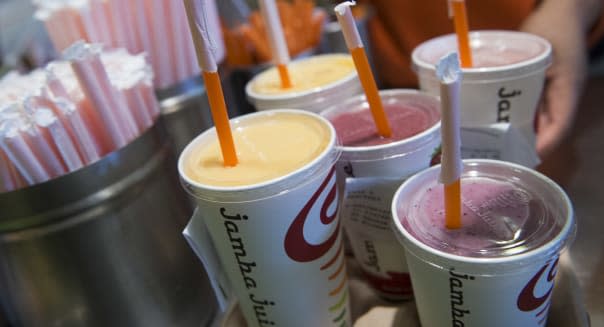Jamba Juice Explores a Future Beyond Smoothies

There were plenty of positives when Jamba Juice parent Jamba (JMBA) reported quarterly results after the market close on Thursday.
Jamba wrapped up its second consecutive year of profitability and its third straight year of positive comparable store sales. System-wide comps only rose 0.3 percent for the quarter, but that's not too shabby given the large number of dining institutions putting out negative comparable store sales during the period. If a wintry December kept diners away from traditional eateries, it's a miracle that they turned out for smoothies, which typically see sales dry up when the weather turns chilly.
Yes, Jamba posted a quarterly loss. This remains a seasonal business with sales peaking during the summer, when icy fruit drinks come as a welcome refreshment. However, the fourth quarter was the only period in 2013 that Jamba beat Wall Street's profit targets.
A World of Competitive Blenders
Jamba Juice remains the largest standalone smoothie chain with 803 locations across the country. Still, it's not the biggest operator selling smoothies. Starbucks (SBUX) began offering blended fruit drinks when it rolled out Vivanno in 2008. McDonald's (MCD) followed two years later by introducing smoothies to its McCafe lineup.
The competition in of itself hasn't hurt Jamba. Some would argue that food and beverage giants getting into the game have helped to educate the market. It's a sound argument, especially since Jamba has gone on to post positive comparable store sales in every complete year since McDonald's got into the game.
Starbucks and McDonald's only have a couple of flavors of smoothies on their menus, but Jamba offers dozens of blended varieties. However, burger chains and coffee shops are selling these drinks at much lower prices than Jamba's concoctions. They may be creating product awareness, but they're also driving the perceived value lower.
Squeezing Out New Opportunities
Jamba is confident about its future. Comparable store sales have been positive through the first two months, and the chain is now targeting positive comps for a fourth consecutive year. However, a major component of its growth strategy is to move beyond the traditional smoothies that have made it so popular.
%VIRTUAL-article-sponsoredlinks%Jamba's been testing a Premium Juice platform at 64 stores. Even though just a third of its stores are company-owned, all but one of the units in the program are owned by Jamba. Offering high-end juice bar offerings has been a hit, and it's no wonder that company-owned stores are holding up better than franchised locations.
Over the years Jamba has also started offering food items such as flatbread pizzas, sandwiches and breakfast wraps. Fruit-topped oatmeal has also become a big part of the story, giving Jamba something warm to sell when the weather starts getting nippy.
Another bold initiative is the Whole Food Blending platform that raises the bar in the "good for you" category. During Thursday night's earnings call, Jamba discussed stronger-than-expected demand for Kale-ribbean Breeze, a beverage that includes kale, mango puree, Greek yogurt and chia seeds. Jamba knows that smoothies may have gotten it this far, but to grow further, it'll have to raise the bar on juice bars.
Motley Fool contributor Rick Munarriz owns shares of Jamba. The Motley Fool recommends McDonald's and Starbucks. The Motley Fool owns shares of McDonald's and Starbucks. Try any of our Foolish newsletter services free for 30 days.

